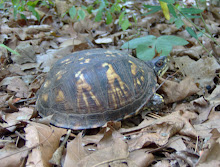
Snowflakes swirled all over campus this afternoon. I strode down the steps of the Biology building, past a woman with her umbrella. she expressed surprise, "Won't it get all over you?". Well, yeah. "Isn't it wet like rain?". Its made of water. People around here were in a panic about weather that I recognize as halfway decent by New York standards.
Still, it was possible to appreciate snow as magical because it was an event, not a constant presence accompanied by months of unrelenting grey skies.
Still, it was possible to appreciate snow as magical because it was an event, not a constant presence accompanied by months of unrelenting grey skies.
I wonder how the lichens are doing.
And the turtles.
The picture was taken last spring and is of lichens growing on a fruit tree--Usnea strigosa and Parmotrema perforatum, which seem to frequently grow together. Lichens are fascinating, and if you ever have the chance to look at them under a dissecting microscope, do so--they look so strange, and yet they are everywhere (everywhere with decent air quality, that is) and often unnoticed. they are ecologically significant, yet ignored. Lichens are pioneers on bare rock, food for arctic animals, and have unusual chemistries and very complicated lives. They have to somehow coordinate reproduction of two different component species to make one lichen. They have strange and beautiful forms. There is a huge book about them by Irwin Brodo, well worth looking at if you get the chance. The lichen flora in this part of Georgia is more diverse than anywhere else I've lived, possibly even seen. Areas in Texas, such as Enchanted Rock, have interesting lichens, but Georgia is hard to beat.




No comments:
Post a Comment